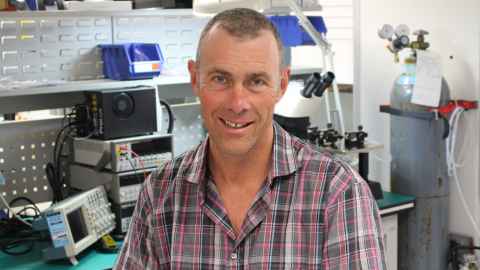Tiny implantable device to measure brain pressure
26 February 2021
Researchers at the Auckland Bioengineering Institute (ABI) have been given a funding boost by Cure Kids, to complete pre-clinical research for a fully implantable pressure sensor device that can be implanted in the brain of people with hydrocephalus, to remotely monitor pressure on the brain.

Cure Kids funding, of $100,000, will allow the team in the Implantable Devices Group at the ABI, led by Professor Simon Malpas, to complete the final, crucial stages of research before the device can be trialled in adults with the disorder.
“Imagine being a new parent and told your baby has an abnormal build-up of fluid on their brain, and we’re going to install a tube to drain the excess fluid,” he says. “At first you’d be relieved there was a treatment, but then you’re told that there’s a good chance the tube will block.”
Hydrocephalus can occur at any age, but is the most common among infants and adults over 60, and one of the most frequently treated neurological disorders worldwide.
It is caused by an obstruction in the circulation of cerebrospinal fluid (CFS) in ventricles deep inside the brain. In normal circumstances CFS delivers nutrients to the brain, and cushions and protects it from injury.
An abnormal build-up of CFS, however, puts pressure on the brain tissue, and can cause a range of impairments in brain function. Current gold standard treatment for hydrocephalus involves the insertion of a drainage tube, or shunt, inside one of the brain’s ventricles, which then drains and diverts excess CFS fluid.
“However, while there has been a gradual improvement in shunt design over the last 40 years, in children 50% of them fail due to blockage within two years,” says Dr Malpas.
Parents of children with the disorder live in a perpetually anxious state, of knowing the shunt will eventually fail, but no way of telling if and when it is.
Knowing that the shunt could fail is, for those with the disorder and their care givers, a constant source of anxiety. Warning symptoms of a shunt failing includes irritability, headaches and vomiting, but around 70% percent of perceived symptoms of shunt failure can be caused by other health issues.
“This means that parents of children with the disorder live in a perpetually anxious state, of knowing the shunt will eventually fail, but no way of telling if and when it is,” says Dr Malpas.
Children taken into the emergency department for suspected shunt failure, will undergo a CT (computerised tomography) scan of the ventricles to check for dilation. Which, apart from the stress and anxiety involved, often results in hospitalisation and exposes the patient to sometimes unnecessary radiation.
For the past four years and thanks to a large-scale MBIE programme grant, Dr Malpas and his team have been developing a tiny, novel implantable pressure sensor, the size of a few grains of rice. This would be inserted in patients with hydrocephalus, alongside and at the same time as the shunt is.
Their device will save lives, save those with it and/or caring for those with the disorder from unnecessary anxiety, and patients from unnecessary hospitalisation and radiation exposure. “We also estimate that it will significantly reduce healthcare costs.”
Dr Malpas’ team includes Peter Heppner, paediatric neurosurgeon, ADHB, and Sarah-Jane Guild, Faculty of Medical and Health Sciences at the University of Auckland.
“We believe our technology will change the care of these patients, from reactive care to proactive monitoring, resulting in much better health outcomes,” says Dr Malpas.
“It also represents a major advance in the potential of telehealth, to use such technologies to meet the needs of patients and their caregivers, no matter they live or their socioeconomic status.”
Media contact
Margo White I Media adviser
DDI 09 923 5504
Mob 021 926 408
Email margo.white@auckland.ac.nz